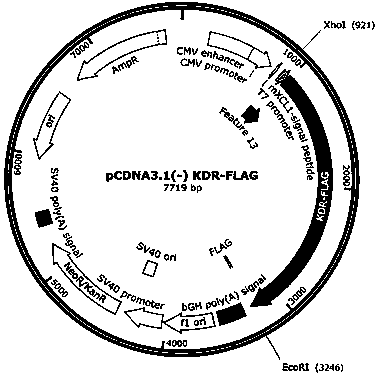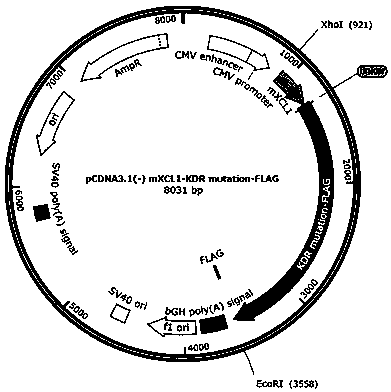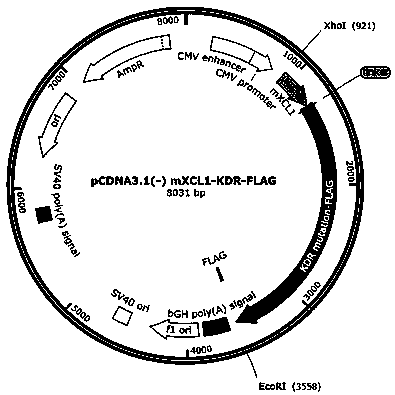VEGFR2-targeting metastatic cancer vaccine
A metastatic cancer, specific technology, applied in the field of cancer immunotherapy and prevention, can solve the problems of limited immune response, ineffective induction, and limited vaccine effectiveness.
- Summary
- Abstract
- Description
- Claims
- Application Information
AI Technical Summary
Problems solved by technology
Method used
Image
Examples
Embodiment 1
[0060] Example 1 Design of Fusion Protein Vaccine Antigen and Construction and Preparation of Expression Plasmids in Mammalian Cells and Insect Bad Cells
[0061] (1) Construction of fusion gene mammalian cell expression vector:
[0062] Construct the fusion protein XCL1-VEGFR2 according to the amino acid sequence of mouse VEGFR2 (SEQ ID No.1 and SEQ ID No.2) and mouse XCL1 (SEQ ID No.4) protein, in order to promote the nucleic acid that expresses fusion protein to translate out in vivo The fusion protein can be effectively secreted to the outside of the cell and chemoattract MHC-II+CD11c+CD8a+antigen cross-presenting DC cells. We retained the secretion signal peptide of the XCL1 protein (SEQ ID No.5), and at the same time, VEGFR2 mediated cell cross-presentation The membrane-localized signal peptide was removed (SEQ ID No. 6). Amino acid sequences of the final fusion protein (SEQ ID No.7 and SEQ ID No.8). For a single VEGFR2 protein, the secretion signal peptide of the XCL1...
Embodiment 2
[0070] Example 2 Prediction of three-dimensional structure of fusion protein
[0071] According to the nucleotide sequence of the fusion protein, we used the http: / / raptorx.uchicago.edu / website to predict the three-dimensional structure of the XCL1 and VEGFR2 extracellular region fusion protein. XCL1 is a chemokine, and its normal chemotactic function needs to maintain a complete spatial structure. In order to ensure that XCL1 still retains its own spatial structure after the fusion of the extracellular region of XCL1 and VEGFR2, we predicted the three-dimensional structure of the fused amino acid sequence on the http: / / raptorx.uchicago.edu / website, and the results are as follows figure 2 It was shown that after the fusion of XCL1 and VEGFR2, the two still retain their original spatial structure, which does not affect the chemotactic function of XCL1.
Embodiment 3
[0072] Example 3 Detection of expression effect of mammalian cell expression vector encoding XCL1-VEGFR2 fusion protein
[0073] 24 hours before transfection, seed 1*10 cells in a 6-well cell culture plate 6 A HEK293T cell, and the transfection experiment was started when the cell density reached 70%-80%. Before transfection, pre-warm the cell culture medium and serum-free Opti-MEM medium in a 37° water bath. During transfection, add 5 μg of empty vector (Vector), separate VEGFR2 expression vector, XCL1-VEGFR2 wild-type and mutant fusion gene plasmids and 20 μL of PEI transfection reagent to 200 μL of serum-free Opti-MEM, mix well , let stand at room temperature for 10 minutes. Replace the cells to be transfected with fresh medium, gently add the above transfection system, and shake gently. Return the cells to the cell culture incubator for 6 hours before changing the medium. After 48 hours of transfection, the cells were harvested and Western Blot was used to detect the e...
PUM
 Login to View More
Login to View More Abstract
Description
Claims
Application Information
 Login to View More
Login to View More - R&D
- Intellectual Property
- Life Sciences
- Materials
- Tech Scout
- Unparalleled Data Quality
- Higher Quality Content
- 60% Fewer Hallucinations
Browse by: Latest US Patents, China's latest patents, Technical Efficacy Thesaurus, Application Domain, Technology Topic, Popular Technical Reports.
© 2025 PatSnap. All rights reserved.Legal|Privacy policy|Modern Slavery Act Transparency Statement|Sitemap|About US| Contact US: help@patsnap.com



